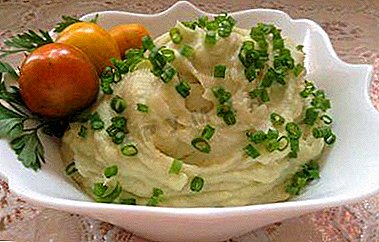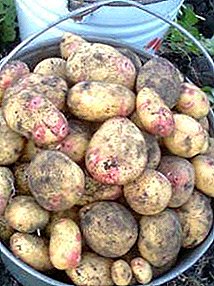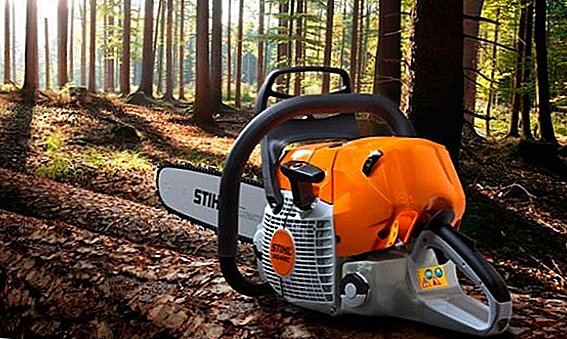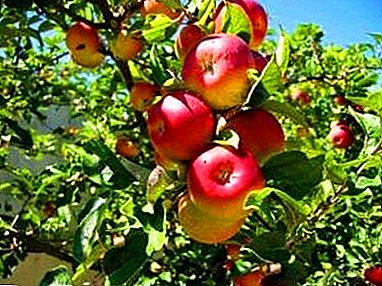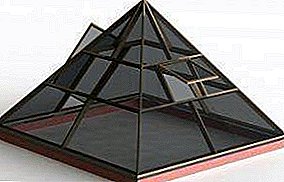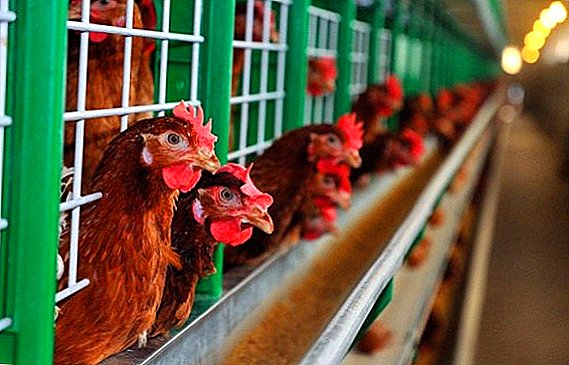 Zamia is a medium-sized plant resembling a palm tree. Its name is translated from Latin means "loss" or "damage." Despite this unattractive name, this flower can become a real exotic interior decoration. This article provides simple recommendations, armed with which you can grow a luxury mane in your own apartment.
Zamia is a medium-sized plant resembling a palm tree. Its name is translated from Latin means "loss" or "damage." Despite this unattractive name, this flower can become a real exotic interior decoration. This article provides simple recommendations, armed with which you can grow a luxury mane in your own apartment.
Botanical description of indoor plants
Zamia is a plant of the genus Sagovnikov, family Zamiev. Its homeland is considered to be Central America and Mexico, and the plant’s history goes back over two hundred years. In their natural habitat zamimi grow along the banks of the rivers of Brazil, Florida and Cuba. Representatives of the genus - evergreen low plants, with a look somewhat similar to palm trees. The smooth stem of the plant, which is partially or completely underground, has an elongated, tuberiform shape. Its dimensions vary from 3 cm to 1 m in length.  Glossy, feathery, olive-green leaves on small petioles effectively rise, forming a decorative crown. Sometimes on the underside of the leaf parallel veins stand out strongly. In most species, the petiole is smooth, but in some specimens it has small spines. At home, the representative of the Zamievs genus practically does not bloom and, accordingly, does not give seeds. Decorative interest are feathery leaves.
Glossy, feathery, olive-green leaves on small petioles effectively rise, forming a decorative crown. Sometimes on the underside of the leaf parallel veins stand out strongly. In most species, the petiole is smooth, but in some specimens it has small spines. At home, the representative of the Zamievs genus practically does not bloom and, accordingly, does not give seeds. Decorative interest are feathery leaves.
Important! All parts of the plant are poisonous to animals and humans. Toxic substances cause hepatic and renal failure, as well as paralysis. When poisoning occurs very quickly dehydration.
The plant is unpretentious in care and differs in endurance. With its slow growth and good conditions of maintenance, specimens can reach almost 2 m in height and 1 m in width. At the base of the plant, empty cone-strobes appear, which is why the flower got such a strange name.
Types of plants Zamiya
The genus Sagovnikovy includes 58 different species.
The most common ones are:
- Dwarf zamia. The smallest of all representatives. The size of the trunk under the soil reaches 25 cm in length and about 3 cm in thickness. The leaves of the plant - from 5 to 50 cm, strobila - up to 5 cm.
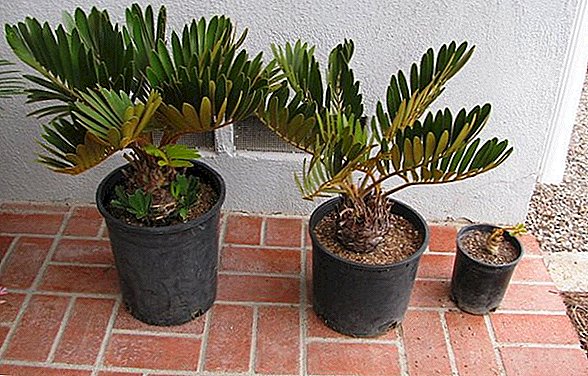
- Siliceous. The stem is completely underground. Foliage spread over the surface (from 3 to 5 pieces). It is adapted to feed on substances from the tuberiform underground trunk.
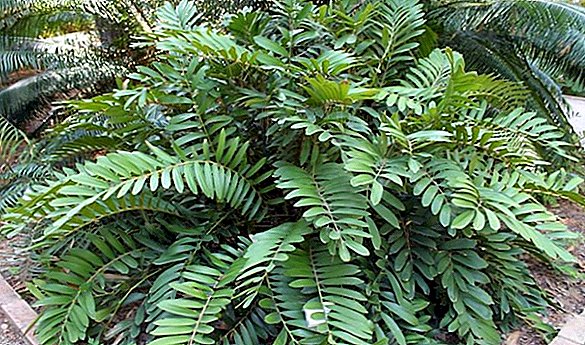
- Florida. The root is elongated, long. Above the ground is the strobile (in females it is lying). The leaves are smooth, with leather tint. The trunk is of medium length.

- Broadleaf. The trunk height of 10 cm, the part is located above the soil. Leaves up to 1 m.

- Husky. The height of the trunk is up to 1 m. In the form of an indoor flower, the part of the trunk that should be under the soil, protrudes above the ground. The crown is dense, the leaf plates are covered with fibers. Sheet size - up to 1 m.
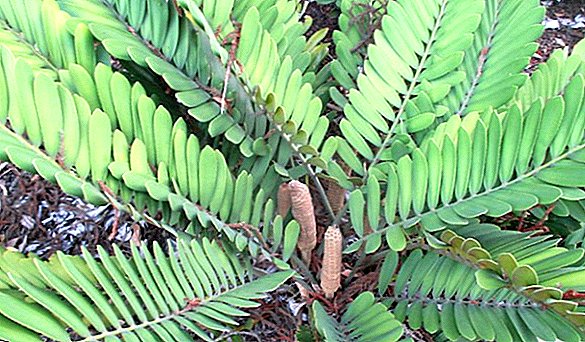
- Rough (zamiya powdered, cardboard palm) is a squat slow-growing plant, not more than 1.3 m high. The trunk is short, usually underground. The leaves are hard, pinnate, 50-120 cm long.

Conditions for growing at home
The flower is recommended for keeping in spacious halls, rooms, salons, offices, offices, shop-windows or cafes.
Did you know? To the touch, the leaves of the zamhavoy (Cardboard palm) are very specific, resemble cardboard, hence the name "cardboard palm".
Location and lighting
The ideal place in the living room for the content of palm trees - the windows of the south. It also adapts to windows facing west or east. In order to grow a beautiful plant with a uniformly developed rosette of leaves, a pot of flowers must be turned from time to time on different sides to the light.
However, the windows of the northern direction of the culture may not have enough light for normal development. Zamia prefers a bright light. But keep in mind that it can not be transferred directly to the sun. Teach the flower to the direct sun gradually, in order to avoid burns on the leaves. And in a hot afternoon culture is best pritenyat. 
Temperature conditions
In the spring and summer seasons, the comfortable temperature for the plant is + 25 ... + 28 ° С, while in winter the indicator is reduced to + 14 ... + 17 ° С.
Air humidity
Zamia can withstand sufficiently dry room air. Additional measures to increase air humidity are not required. However, in spring and summer, you can spray the plant with soft water at room temperature.
Important! Zamia does not like air stagnation, so the room must be constantly aired. Also it is impossible to allow through winds.
Home care
When caring for this exotic plant, be guided by the natural conditions of its growth. In a comfortable environment for itself, this palm tree is actively growing and developing.
Watering rules
From March to the end of August, water the flower abundantly, as the top layer of the substrate dries out, with soft settled water. Since autumn, reduce watering, especially with cool content. In winter, occasionally you can moisten the soil, preventing both its overflow and full drying.  The most acceptable method of soil moistening is watering from above using a watering can with a long spout. Use warm rainwater or tap water, but defended in advance.
The most acceptable method of soil moistening is watering from above using a watering can with a long spout. Use warm rainwater or tap water, but defended in advance.
Top dressing
In the spring and summer, feed the flower every month with the help of complex fertilizer for decorative leafy plants. In the fall and winter, Zamia does not need fertilizers.
Pruning
Zamiya - slow growing culture. Sometimes you can spend a whole year, or even more, wait for the next sheet to appear, so pruning is contraindicated. Bushness is not add, and will be able to destroy.
Check out the list of the most common types of palm trees.
Transfer
Transplantation of plants produced in spring and summer as needed, but the best time is before the start of a new growth.
Identify the flower in the new pot as follows:
- Prepare a medium-sized pot (tall and wide is useless here, since the Zamia grows very slowly). The pot should have drainage holes.
- Add a little nutritious, well-structured soil mixture of medium density (equal parts of sod land, leaf soil, humus, peat and sand with the addition of fine granite chips). At the bottom of the pot provide good drainage.
- Carefully remove the plant without disturbing the coma of the earth.
- Pass the rhizome into a new pot.
- Add fresh soil mixture on the sides, slightly tamping it.

Rest period
The dormant period is in the winter. The flower is kept in a bright cool (+ 14 ... + 17 ° C) place, watered carefully.
Breeding
Can be propagated by seed or cuttings. Consider the main nuances of each process.
Cuttings
Cuttings must first be put into the water. When the roots appear, they are planted in the soil.
Did you know? American Indians used leaves of zamie for making clothes.
Seeds
Sowing seeds is carried out in a light earth mixture. They are submerged only 1/2 part of the diameter. Then the container is covered with a film or glass and transferred to a warm room. Appeared sprouts are diving into small individual tanks. 
Difficulties in growing
Zamiya is not very susceptible to diseases, but if conditions of detention are violated, it can die.
To prevent this from happening, their owners need to know how to solve basic problems:
- the flower withers and rots the base of the stem - too abundant watering in winter;
- brownish, dry specks on foliage - lack of mineral substances or too poor watering;
- the plant abruptly dropped foliage - it was watered with cold water or watering too little;
- leaves turn pale - on the foliage in the summer afternoon for a long time to get the sun's rays.
Learn how to grow Areca palm trees.
Dilute drugs according to the instructions to the desired concentration. Treat the flower until it is completely free from harmful insects. If you are patient nature and love exotic plants, by all means try to start a zamiyu. Spectacular evergreen flower is sure to be the main decoration of the interior room.









